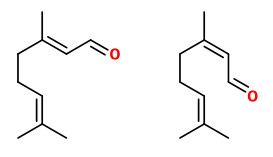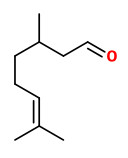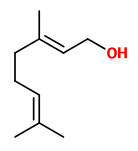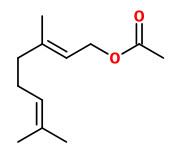Benutzer-Werkzeuge
Leptospermum petersonii F. M. Bailey - syn.Leptospermum citratum (J.F.Bailey & C.T.White) Challinor et al.; Leptospermum flavescens var. citratum J.F.Bailey & C.T.White - Myrtaceae - lemon-scented tea tree, Zitronenduft-Teebaum, Zitronenmyrte
Shrub or small tree, up to 5m tall, native to the east coast of Australia, cultivated as an ornamental and for essential oils; leaves fragrant, alternate, simple, lanceolate, 2-4cm long; flowers white.
„The leaves are distilled commercially for the essential oil… It is grown in plantations in Kenya, Zaire, South Africa, Guatemala and Australia. The leaf of lemon-scented teatree is also used as a flavouring ingredient in boutique tea blends with standard black tea, Camelia sinensis.“ https://en.wikipedia.org/wiki/Leptospermum_petersonii
„The oil of L. petersonii was found to occur in chemical varieties, with much variation in most of them. Variety 1 contained aldehydes, ranging from high citronellal and low neral/geranial to low citronellal and high neral/geranial. Two oil chemotypes, comprising mainly hydrocarbons, were identified. One chemotype, corresponding to Penfold's ‘variety A’, contained mainly monoterpenes, while a newly discovered chemotype contained mainly sesquiterpenes, with either β-caryophyllene or globulol/viridiflorol/spathulenol as major components. The existence of a further chemotype, corresponding to Penfold's ‘variety B’, containing geranyl acetate (21-38%) and geraniol (21-29%), was also confirmed. A study of the cotyledon and seedling leaf volatiles of a form of L. petersonii, the parent of which was rich in citronellal and neral/geranial, showed that both cotyledons and seedling leaf volatiles consisted of only sesquiterpene hydrocarbons, being δ-elemene, bicycloelemene, β-elemene, germacrene-D and bicyclogermacrene. It was not until the seedling had 15 nodes (ca. 170 mm tall) that citronellal and neral/geranial were found in the leaves above the fifth node.“
[Leaf essential oils of the genus Leptospermum (Myrtaceae) in eastern Australia. Part 7. Leptospermum petersonii, L. liversidgei and allies., Brophy, J.J., Goldsack, R.J., Punruckvong, A., Bean, A.R., Forster, P.I., Lepschi, B.J., Rozefelds, A.C., Flavour and fragrance journal, 15(5), 2000, 342-351]
Main components the essential oil of L.petersonii (different from other Leptospermum oils) were the two citral isomers, neral (21.2%) and geranial (28.8%), a further 20% of the oil was represented by citronellal (19.6%). Other characteristic components were the corresponding alcohols (nerol, geraniol, citronellol) and their acetates. Minor characteristic constituents were isopulegol (2.5%) and 6-methyl-5-hepten-2-one (0.4%).
[Christoph, F. (2001). Chemische Zusammensetzung und antimikrobielle Eigenschaften der ätherischen Öle von Leptospermum scoparium JR et G. Forst. und anderer Teebaumöle der Gattungen Kunzea, Leptospermum und Melaleuca unter besonderer Berücksichtigung von Handelsölen (Doctoral dissertation, Dissertation, Universität Hamburg)] http://ediss.sub.uni-hamburg.de/volltexte/2001/448/pdf/Dissertation.pdf
L.petersonii essential oil volatiles are acting both directly and indirectly (independent of direct contact between the liquid oil and the fungal membrane) on the fungi Candida albicans and Aspergillus fumigatus to produce growth inhibition. L. petersonii's mode of action is most likely through disturbance of the fungal cell membrane, it may also be inhibiting H+-ATPase.
[The effect of Leptospermum petersonii essential oil on Candida albicans and Aspergillus fumigatus., Hood, J.R., Burton, D.M., Wilkinson, J.M., Cavanagh, H.M.A., Medical mycology, 48(7), 2010, 922-931] http://mmy.oxfordjournals.org/content/48/7/922.full

CC BY-SA 3.0, Author: RaffiKojian Wikimedia Commons




